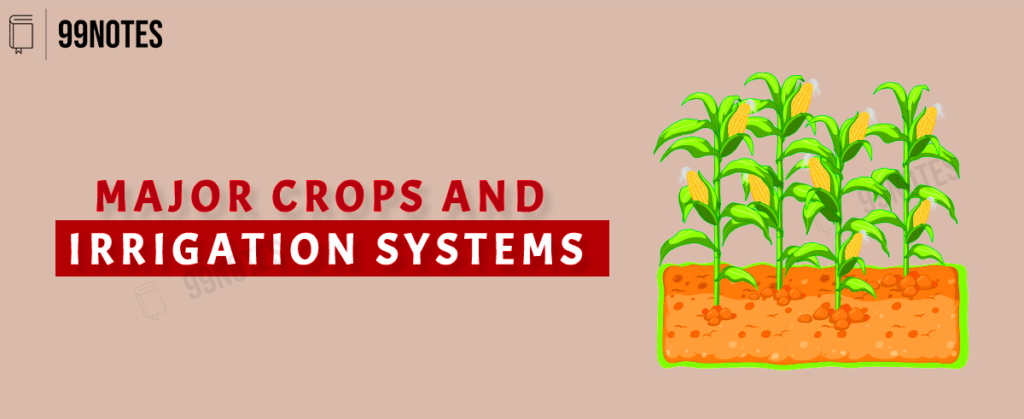
Major Crops & Irrigation System Free UPSC Notes Download
Major Crops & Irrigation System
If agriculture is the lifeblood of the Indian economy, then infrastructure is the arteries and veins required for the sector’s and the economy’s survival and expansion.
Infrastructure, mostly physical, in the agriculture industry refers to the facilities that aid farmers from planting to selling, including irrigation, road connectivity, electrification, storage, and communications.
Infrastructure investment results in lower costs per input, increased productivity, additional revenue creation, and capacity growth. It contributes to the development of rural regions, the alleviation of hunger and poverty, and the protection and management of natural resources.
There are many major crops grown around the world and the specific crops grown in a particular region depend on a variety of factors such as climate, soil type, and market demand.
Some common major crops include:
- Wheat: Wheat is a cereal grain and is one of the most widely grown and most important crops in the world. It is grown on every continent except Antarctica and is a staple food for many people.
- Rice: Rice is another cereal grain and is the most important staple food for a large part of the world’s population. It is grown in many countries, but the largest producers are China, India, Indonesia, Bangladesh, and Vietnam.
- Corn: Corn, also known as maize, is a cereal grain and is one of the most widely grown crops in the world. It is used for food, feed, and industrial purposes.
- Soybeans: Soybeans are a type of legume and are an important source of protein, oil, and feed. They are grown in many countries, but the largest producers are the United States, Brazil, and Argentina.
- Cotton: Cotton is a fiber crop and is grown for its seeds, which produce oil and protein, and for its fibers, which are used to make textiles. The largest producers of cotton are China, India, the United States, and Pakistan.
Irrigation systems are used to provide water to crops when natural rainfall is insufficient.
There are many different types of irrigation systems, including surface irrigation, which involves the application of water to fields from above the ground using channels or furrows, and drip irrigation, which involves the delivery of water to the roots of plants through a network of tubes or pipes.
Need for Irrigation
The purpose of irrigation systems is to facilitate the growth of agricultural crops and plants by supplying the lowest quantity of water necessary, minimising weed growth in grain fields, and reducing soil compaction.
- In India, two-thirds of all cropland requires irrigation.
- India’s monsoon precipitation is unpredictable, unreliable, irregular, seasonal, varied, and unevenly distributed.
The characteristics of the monsoon and its impact on Indian agriculture that necessitate irrigation are as follows:
- Uncertain arrival time
Particularly variable in areas with little precipitation, such as Punjab, Haryana, and West Uttar Pradesh. (High covariance coefficient)
Variation in the geographical distribution of precipitation, e.g. Meghalaya receives significantly more precipitation than Thar Desert.
- 30% of agricultural land receives adequate precipitation of above 100 cm. In regions with heavy precipitation, irrigation is also required to boost agriculture output.
- In the absence of irrigation facilities, monsoon gaps (two or more weeks without precipitation during the sunny season) may harm crops.
- 75% of annual rainfall occurs in 3–4 months, with the remaining 8–9 months characterised by the dry season, during which irrigation is crucial for agricultural growth (5 months dry in Kerala, 9 months dry in NW India).
- In the majority of India, rainfall is torrential; consequently, there are less opportunities for soil to absorb water, and surface water is wasted. Also, rainwater flows rapidly downhill along the slopes of the hills.
- Irrigation is required to eradicate monoculture agricultural practises in India.
- Irrigation is also crucial for rural India’s socioeconomic transition, as it makes agriculture varied.
- Certain crops, such as rice, sugarcane, jute, and cotton, require more water and irrigation even in regions with abundant precipitation.
- Since the green revolution, the introduction of HYV seeds and large quantities of chemical fertilisers has made irrigation vital.
- The ability of sandy and loamy soil to hold water is inferior to that of alluvial and black soil.
- Population growth results in more intensive agriculture, necessitating additional irrigation infrastructure and other inputs.
- Irrigation is required to provide critical moisture for plant growth, which includes the movement of essential components.
Irrigation is necessary to leach or dilute soil salts.
To enhance productivity, cropping intensity, or gross cropped area, it is important to expand the irrigation network.
The yield of irrigated crops is predicted to be between 50 and 100 percent more than that of non-irrigated crops under comparable geographical conditions.
India’s major irrigation projects
The major usage of water in India is irrigation. Irrigation projects are engineering constructions that gather, transport, and deliver water to agricultural fields for crop production. Irrigation projects are always of varying sizes. Major irrigation projects are always contingent on the Cultivable Command Area, or CCA. Culturable Command Area refers to the land on which a crop is cultivated during a specific season or time. When the CCA exceeds 10,000 hectares, the project is referred to as a big irrigation project. When the project is completed in its entirety, it will include enormous water reservoirs, flow diversion structures, and massive networks of canals for the entire region, as well as solar canals.
- On the Sutlej River in Punjab and Himachal Pradesh, this irrigation project with a CCA of 40,000,000 hectares was finished in 1963.
- Beas Project: On the Beas river in Punjab, Haryana, and Rajasthan, this project with a CCA of 21,00,000 acres was finished in 1974.
- On the Harike River in Punjab, the Indira Gandhi Canal was constructed in 1965 with a CCA of 5,28,000 hectares.
- In 1954, the Kosi Project was finished with a CCA of 8,48,000 hectares along the Kosi River in Bihar and Nepal.
- It is situated on the Mahanadi River in the state of Orissa and has a CCA of 10,000,000 hectares.
- This project was finished in 1953 on the Tungabhadra-Krishna River in Andhra Pradesh and Karnataka with a CCA of 5,74,000 hectares.
- It was built in 1960 on the Krishna River in Andhra Pradesh with a CCA of 13,13,000 acres for the Nagarjuna Sagar Project.
- On the Chambal River in Rajasthan and Madhya Pradesh, the Chambal Project was finished in 1960 with a CCA of 5,15,000 acres.
- 1948 saw the completion of the Damodar valley project on the Damodar River in Jharkhand and West Bengal, with an area of 8,23,700 hectares.
- Gandak Project was implemented in 1970 on the Gandak river in Bihar and Uttar Pradesh with a CCA of 16,51,700 hectares.
- In 1954, the Kakrapara Project was implemented on the Tapti River in the Gujarat area with a CCA of 1,511,180 acres.
- This irrigation project was built in 1964 on the Koyna-Krishna River in Maharashtra as part of the Koyna project.
- The Malprabha Project was undertaken in 1972 on the Malprabha river in Karnataka with a CCA of 2,18,191 hectares.
- Mayurakshi Project: This project was implemented on the Mayurakshi river in West Bengal in 1956 with a CCA of 2,400,000 hectares.
- Kangasabati Project: It was initiated in 1956 on the Kangasabati River in West Bengal with a CCA of 3,48,477 hectares.
The topic of major crops and irrigation systems is important for the UPSC Civil Services Exam because it relates to a number of key issues and challenges that India and other countries face.
First, the production and management of major crops is a vital part of India’s agriculture sector, which is a major contributor to the country’s economy and a key source of employment for many people. Understanding the importance and challenges of different crops and irrigation systems can help policymakers to develop effective strategies for supporting the agriculture sector and addressing issues such as food security and rural development.
Second, major crops and irrigation systems are also important in the context of environmental sustainability. The way in which crops are grown and irrigated can have significant impacts on natural resources such as water and soil, and understanding these impacts can help policymakers to develop more sustainable and environmentally responsible practices.
Finally, the topic of major crops and irrigation systems is also relevant in the context of global trade and economic development. Many countries, including India, are major producers and exporters of certain crops, and understanding the global market for these crops and the factors that influence production and trade can help policymakers to make informed decisions about trade policy and economic development.
Related Links:

